Using LinkedIn to recruit grad students at (almost) every phase of the admissions funnel
7/25/2024
In the digital world, competition is everywhere. Many people see LinkedIn as a social media platform that’s strictly for professionals, and so they don’t consider it for reaching prospective students. But the platform can actually be an important tool to include in your media strategy.
As of January 2023, roughly 60 percent of LinkedIn users globally were aged 25 to 34, and about 20 percent of users were 18 to 24. While these numbers don’t really work well for engaging undergraduates, LinkedIn is in a prime position to reach people who are considering paths to continuing education, such as an MBA or other postgraduate degree. With thousands of options for these individuals to choose from, it’s important for higher education institutions to get in front of prospects wherever they may be online. Read on to see how LinkedIn can be valuable in achieving this goal throughout the admissions funnel.
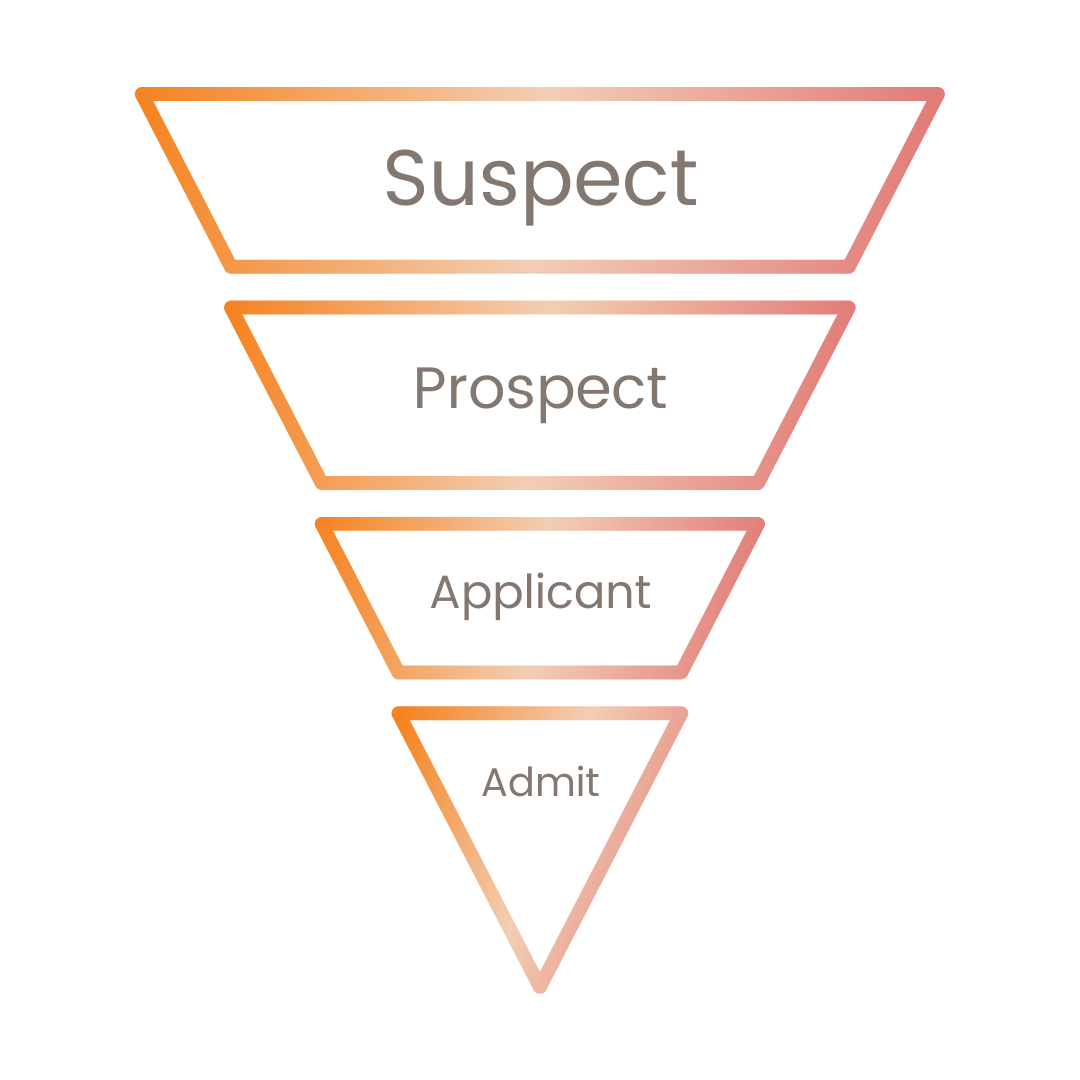
Awareness (Suspects)
LinkedIn has a wide array of native targeting capabilities, including by job experience, age and gender, education, company, interests and traits, and more. You can layer these options together to specifically zero in on graduate students, but you can also keep things broad to drive higher reach across the site. You can also target users based on geographic location within the United States, as well as countries like the UK, Australia, France, and others.
LinkedIn offers advertisers multiple types of creative that can reach users across the platform or on partner sites. Among the various options available, the best ad units for building awareness are sponsored content and spotlight ads.
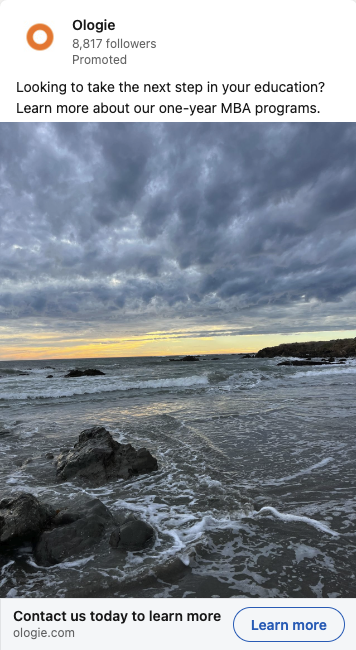
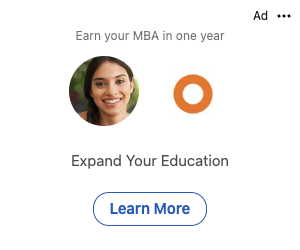
With sponsored content, LinkedIn places your ad in a user’s home feed, showing it along with other content that users see as they scroll. Photo, video, and carousel ads are available; we recommend all three varieties so that users see your ad in the way that best engages them. For example, some prospective grad students might respond better to a video ad with details about your school and what the program offers them, while other users might be more likely to engage with a carousel ad that tells a story as they swipe through images.
On the other hand, spotlight ads are placed only with desktop users, which allows for a larger impression, especially when paired with sponsored content. This option combines your logo and the user’s profile picture to help the user imagine themselves at your college or university.
When you add LinkedIn’s native targeting to sponsored content and spotlight ads, you can build awareness and reach prospects who may not know who you are, but who might be considering a field of study you offer.
Note: LinkedIn also offers brand lift studies, which enable you to track metrics like ad recall, brand favorability, and other high-level measures of awareness in your target audience. These studies provide an extra layer of insights to inform your strategy and ensure that the right message is reaching the right audience.
Consideration (Prospects)
Once a prospect is aware of you, it’s time to make sure they consider you when they’re ready to take the next step. This is the phase where retargeting audiences can play a key role. LinkedIn allows you to retarget users who have engaged with your sponsored content (photo ads or video ads). With this method, you can reach users who are already aware of you, and encourage them to schedule a visit or request more information about your graduate programs.
Here you can choose from two alternatives for campaign optimization. One focuses on getting users to your website, ideally landing on a page where they can take action and progress further in the funnel. Another option takes advantage of LinkedIn’s lead generation ads, where users can fill out a contact form without ever having to leave the site. LinkedIn can pre-populate certain fields of the form based on the user’s profile information, which makes conversion even easier. You can connect these lead forms to various third-party partners for easy integration with your current CRM system.
One benefit of generating leads right within the platform is that, once a user submits your contact form, they’re removed from the related list and no longer see these ads. This helps ensure that you’re reaching relevant audiences without spending money on users who have already taken the action you desire.
Application (Applicants)
As prospective grad students move past the consideration stage and are ready to apply, you can use more detailed targeting to get your messages to them. LinkedIn provides various options here, like uploading custom lists and retargeting based on website traffic. With custom lists, you can use your first-party data on prospective students to send them detailed, personalized messages that encourage them to perform lower-funnel actions, like applying. Retargeting can effectively reach users who have visited your website, since these users already show intent and are further along the funnel. Retargeting by website traffic can also use specific pages, like your graduate programs page, for an even more targeted approach.
While LinkedIn has multiple different creative formats that can be used at this stage, the two that you should consider are message ads and conversation ads.
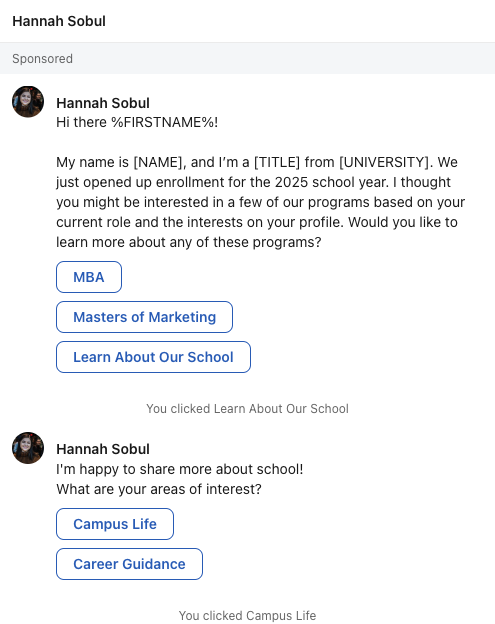
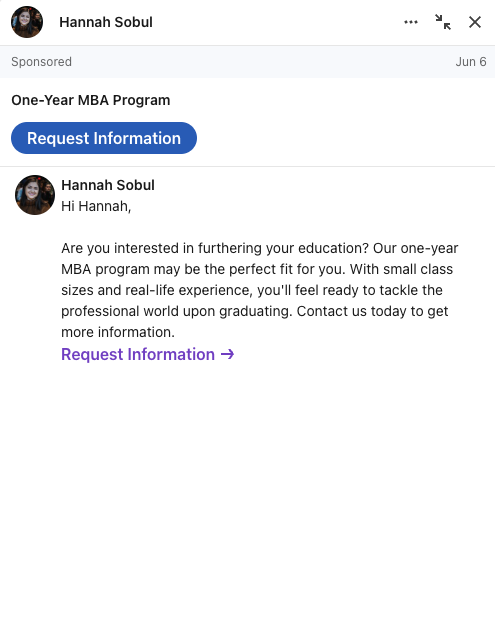
Message ads appear as sponsored InMail messages to a prospect from your institution. They’re highly customizable, with a single call to action that can take users straight to the application page on your website. Conversation ads are similar in that they’re sponsored InMail ads; however, they have a longer user flow and multiple calls to action. This option lets you give users more details that they might need before they’re ready to apply.
Evaluation (Admits)
Once a prospect has applied and been accepted, they’re in the final stage of the funnel, where LinkedIn can again be a valuable platform. Committing to an institution is a big decision, but LinkedIn can help keep you top of mind during this process. As in the applicant stage of the funnel, you can use first-party data lists for admitted students to develop a highly targeted approach for converting users. For example, you can send message ads with a single call to action for submitting a deposit. And again, once users submit their deposit, they can be excluded from further messages, if you upload a first-party data list to remove these users from the campaign’s targeting.
Note: The biggest roadblock that institutions can encounter at this phase is the matched audience size. The minimum number of rows for an uploaded list for LinkedIn is 300. If your list is smaller than 300 rows, or you can’t match 300 rows within LinkedIn, list targeting will be unavailable. If list targeting cannot be used for this funnel phase, LinkedIn advertising can only be used for actions at the top and middle of the funnel.
Recap
- To build awareness: Broad targeting and mixed placements are key for success at the beginning of the enrollment cycle.
- To drive consideration: Stage-specific messaging, along with retargeting or first-party data for targeting, will drive more action throughout the enrollment cycle.
- To drive apps and admits: Longer-form messaging and first-party data will help drive more applications and deposits at the end of the enrollment cycle.
By reaching users throughout the enrollment process, you can help keep your school top of mind among your competitors. And since LinkedIn users are already in a more professional mindset and prospective grad students fit the age range most likely to be on the platform, LinkedIn can be a valuable marketing channel for graduate recruitment.




